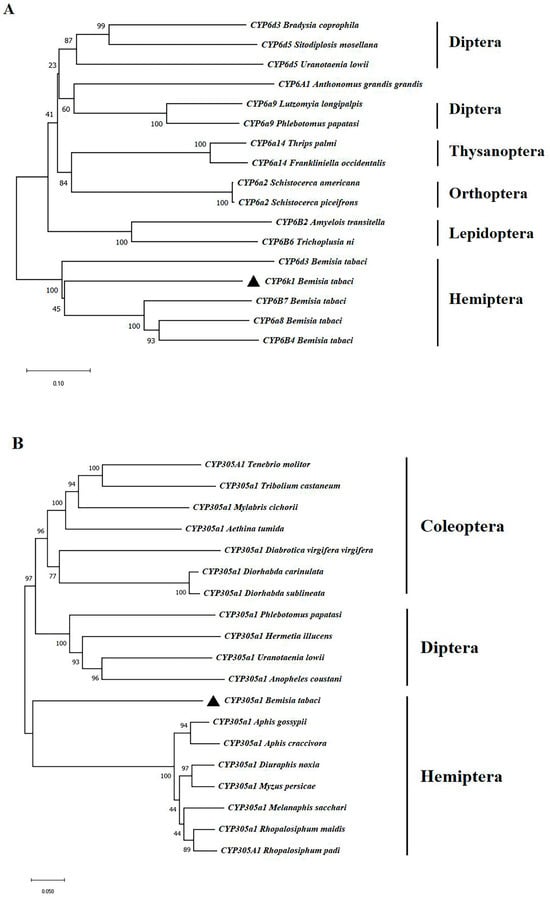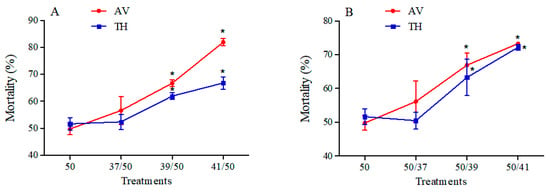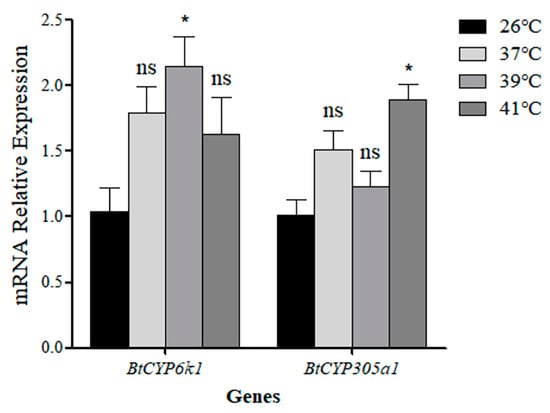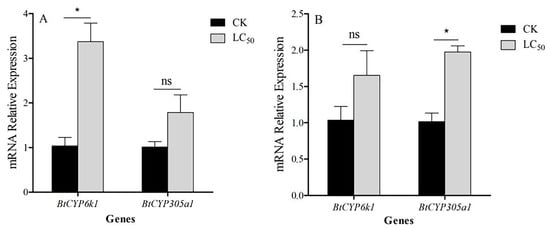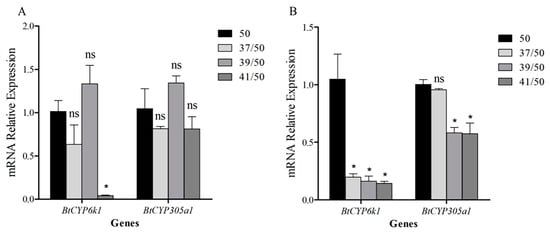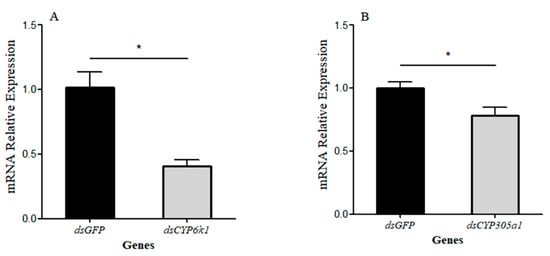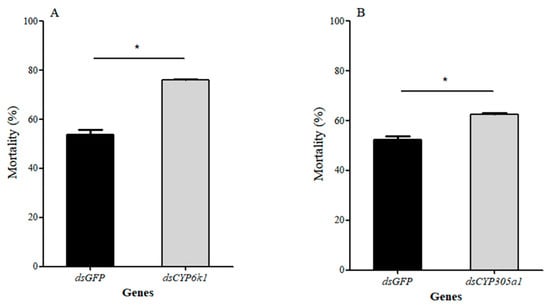Abstract
Simple Summary
Bemisia tabaci (Gennadius) is a worldwide agricultural pest and is one of the most harmful invasive insect pests in the world. The overuse of insecticides has caused B. tabaci to develop high resistance against multiple insecticidal chemicals. It is well recognized that over-expression of cytochrome P450s involved in insecticide detoxification is one common and major mechanism of resistance to various classes of insecticides in insects. In addition to gene duplication and amplification, up-regulation of P450s at the transcriptional level is a common and important mechanism for P450-mediated insecticide resistance. Here, two new CYP450 genes from B. tabaci MEAM1 were cloned, and their expression patterns were studied in response to two different insecticides, high temperature, and their combined effects. The results showed that the insecticide tolerance could be reduced by high temperatures; under combined stress, the mortality of B. tabaci MEAM1 increased. This study is an important addition to the research on insecticide tolerance in B. tabaci and may help to reduce the overreliance on insecticides for B. tabaci control.
Abstract
Bemisia tabaci (Gennadius) is one of the most important invasive species in China, with strong insecticide resistance and thermotolerance. In this study, we investigated the effects of elevated temperature on the tolerance of B. tabaci MEMA1 to abamectin (AB) and thianethixam (TH) insecticides. We firstly cloned two new CYP450 genes from B. tabaci MEAM1, including one CYP6 family gene (BtCYP6k1) and one CYP305 family gene (BtCYP305a1). The expression patterns of the two BtCYP450 genes were compared in response to high-temperature stress and insecticide exposure, and RNAi was then used to demonstrate the role that these two genes play in insecticide tolerance. The results showed that expression of the two BtCYP450 genes could be induced by exposure to elevated temperature or insecticide, but this gene expression could be inhibited to a certain extent when insects were exposed to the combined effects of high temperature and insecticide treatment. For AB treatment, the expression of the two BtCYP450 genes reached the lowest level when insects were exposed to a temperature of 41 °C and treated with AB (combined effects of temperature and insecticide). In contrast, TH treatment showed a general decrease in the expression of the two BtCYP450 genes with exposure to elevated temperatures. These findings suggest that insecticide tolerance in B. tabaci MEAM1 could be mediated by high temperatures. This study provides a prospective method for the more effective application of insecticides for the control of B. tabaci in the field.
1. Introduction
Bemisia tabaci (Gennadius) is a widespread agricultural pest, distributed all over the world except for Antarctica. It is one of the most harmful invasive pests in the world, wreaking havoc on Solanacea, Cruciferaceae, Cucurbitaceae, and other crops [1]. There are three main ways through which B. tabaci can damage crops: (a) the direct ingestion of plant sap, which causes the plant to grow slowly and wilt in severe cases; (b) induction of the secretion of honeydew, which induces sooty mold infections and reduces the plant’s photosynthetic efficiency; and (c) the transmission of plant viruses, especially begomoviruses and criniviruses, which cause plant dwarfing, reduced seed setting, and even plant death [2]. B. tabaci is a cryptoactive complex containing at least 44 cryptic species [3]. Within this species complex, two cryptic species, Middle East–Asia Minor 1 (MEAM1) and Mediterranean (MED), formerly often referred to as the B and Q “biotypes”, are the two most influential invasive B. tabaci cryptospecies [4].
At present, the prevention and control of B. tabaci is still mainly based on chemical control, especially environmentally friendly insecticides such as neonicotinoids. The mechanisms of insect resistance to insecticides mainly include epidermal penetration resistance, target resistance, and detoxification. The main reason for the emergence of pesticide resistance is the improvement of insects’ ability to detoxify and metabolize insecticides [5]. The main enzyme involved in metabolism and detoxification processes is cytochrome P450 monooxygenase (CYP450) [6,7]. Cytochrome P450 monooxygenase is a class of heme and thiolhydroxyl protein widely present in living organisms. P450 is present in all life forms, and it has the two functions of catalyzing the metabolism of many exogenous substances (such as drugs entering the body and toxic substances in the environment) and transforming endogenous substances (such as fatty acids, cholesterol, and steroid hormones) into essential active substances for living organisms [8]. Studies have shown that the resistance of Q-type B. tabaci to nicotinoid insecticides is related to microsomal cytochrome P450 multifunctional oxidase [9]. Karunker et al. (2008) also found that resistance to imidacloprid insecticides in B. tabaci B and Q was positively correlated with the expression level of the P450 CYP6CM1 gene in vivo [10]. Multiple studies have shown that the metabolic activity of the P450 enzyme system is the main mechanism by which most insects develop insecticide resistance [11,12].
Under natural conditions, temperature is one of the most important environmental factors affecting the growth and development of insects [13]. It is also an important factor affecting the resistance of insects to insecticides. High-temperature stress leads directly to protein denaturation and inactivation and water loss in insects, while low-temperature stress causes the cells to freeze and rupture, thereby causing irreversible damage and even death to insects [14]. Previous studies have found that high temperatures affect insects’ resistance to insecticides, and this phenomenon has been reported for many insects, including Plutella xylostella, Tetranychus cinnabarinus, and Spodoptera littoralis [15,16,17]. In Spodoptera littoralis, the susceptibility to lambda-cyhalothrin and methomyl increased with increasing temperature [17]. Also, increased temperature could regulate the tolerance of B. tabaci MED to the insecticide thiamethoxam and was associated with the induction of CYP6CM1 [18]. However, in brown planthoppers and Drosophila, there was no strong correlation between the activities of the detoxifying enzymes and temperature, while the quantity of reactive oxygen species (ROS) increased with temperature [19]. Previous research has shown that temperature tolerance varies significantly between the two invasive whiteflies and the MED species is more tolerant to high temperatures than the MEAM1 species, especially in the adult stage [20]. Therefore, studying the effect of high temperature on the resistance of B. tabaci is of great guiding significance for understanding the invasion mechanism and inferring related predictions.
In this study, we explored the effect of high temperatures on insecticide tolerance in B. tabaci. We first identified two new CYP450 genes from B. tabaci MEAM. Then, the expression patterns of these two BtCYP450 genes were compared under different high temperatures and insecticide treatments to study the interactions between the BtCYP450 genes and temperature stress. Also, the role of CYP450 in regulating insecticide tolerance in B. tabaci MEAM1 was explored via RNAi.
2. Materials and Methods
2.1. Insects
The B. tabaci MEAM1 line used in this research were continuously reared in our laboratory for multiple generations. The MEAM1 cryptic species of B. tabaci was identified via the specific primers described by Liu (2017) [21]. Then, colonies were established indoors on tomato (Lycopersicon esculentum) plants for multiple generations without exposure to any insecticides. The growth chamber was set at 26 ± 1 °C, with a 16 L: 8D photoperiod and 60–70% relative humidity.
2.2. RNA Isolation and Cloning Experiments
Total RNA was extracted from B. tabaci MEAM1 adults using the RNA-easyTM Reagent (Vazyme Biotech, Nanjing, China), and the samples were stored at −80 °C until needed. Full-length cDNAs of genes encoding CYP450s were obtained by means of 5′- and 3′-RACE (SMART RACE, Clontech, Mountain View, CA, USA) using the primers shown in Table S1.
Two putative CYP450 genes were identified based on the transcriptome data [22]; the gene-specific primers used to amplify these genes are listed in Table S1. PCR products were separated using a gel extraction kit (Axygen, Union City, CA, USA) and then cloned into pGEM-T Easy vector (Promega, Fitchburg, WI, USA). Ligation reaction was then used to transfer these genes into competent Escherichia coli DH5α cells for sequencing. Identification of the open reading frames (ORFs) was performed using the online software ORF Finder “https://www.ncbi.nlm.nih.gov/orffinder/ (Accessed: 17 September 2023)”. The physical and chemical properties of the two genes, such as the amino acid sequence translation, relative molecular weight, isoelectric point, etc., were identified using the online software Translate tool “http://web.expasy.org/translate/ (Accessed: 17 September 2023)”. The homology was searched with Blast in NCBI, and MEGA7.0 was used to construct the phylogenetic tree of the two CYP450 family genes of B. tabaci MEAM1 and the CYP450 family genes of B. tabaci and other species, based on the adjacency method.
2.3. Insecticide Bioassays
The pesticide used for bioassays included 1.8% w/w abamectin (AB, Jinan Zhongkekeji Green Bioengineering Co., Ltd., Jinan, China) and 30% w/w thiamethoxam (TH, Jiangsu Jianpai Chemical Industry Co., Ltd., Suzhou, China). The lethal concentrations (LC50) of abamectin and thiamethoxam for B. tabaci MEAM1 were determined via a feeding bioassay: formulated insecticides were diluted with 30% sucrose solution to different concentrations (for AB, it was 0–2 mg·L−1, and for TH, it was 0–15 mg·L−1) with a targeted mortality ranging from 0% to 100%. Fifty B. tabaci MEAM1 adults were randomly placed and transferred into a special feeding tube, one side of which was filled with 300 μL of sucrose solution containing different concentrations of pesticide for feeding while the other side was covered with a screen for ventilation. Adults placed in feeding tubes and fed only with 30% sucrose solution were used as controls. The tubes containing the experimental insects were placed in an artificial climate chamber and maintained at the same relative temperature, humidity, and photoperiod as the colony. The mortality rate was recorded after 24 h. Each treatment consisted of three biological replicates.
2.4. Temperature Treatments
Fifty B. tabaci MEAM1 adults were placed in centrifuge tubes and exposed to temperatures of 37 °C, 39 °C, and 41 °C, respectively, in a thermostatic bath (DC-3010; Jiangnan Equipment, Ningbo, China) for 1 h, and the insects were then left to recover at 26 °C for 1 h after treatment. Control insects were treated at 26 °C, with each treatment including three biological replicates.
2.5. Combined Temperature and Insecticide Treatment
When treated with both elevated temperature and insecticide exposure, the B. tabaci MEAM1 adults were firstly exposed to high temperatures (37 °C, 39 °C, or 41 °C) for 1 h, then survivors were transferred to the feeding tube with the LC50 dose of the insecticide and placed in an artificial climate chamber. The other treatment groups were exposed to the LC50 dose of insecticide and then treated with different high temperatures for 1 h. Mortality was recorded after combined treatment. The two different treatments used the same control: adults exposed to the LC50 dose of the insecticide. Each treatment included three biological replicates.
2.6. RNA Interference
RNA interference analysis was conducted to examine whether the significantly upregulated expression of the two CYP450 genes in B. tabaci MEAM1 played a role in the resistance to abamectin and thiamethoxam. Synthesis of the two CYP450s’ dsRNA and green fluorescent protein (GFP) dsRNA in vitro was based on the instructions of the Thermo ScientificTM TranscriptAidTM T7 High Yield Transcription Kit (Thermo, Waltham, MA, USA). All primers designed to generate dsRNA are listed in Table S1. dsRNA was stored at −80 °C before use.
RNA interference was conducted through directly feeding dsRNA to B. tabaci MEAM1 adults in the feeding tube for 24 h, as described in Section 2.3. dsCYP450 and dsGFP (100 ng/μL) were diluted in 30% (w/v) sucrose for use in the experiments. The effiency of RNA interference was tested 24 h post-feeding. Then, the survivors were transferred to the feeding tube with the LC50 dose of insecticide for 24 h. The mortality rate was recorded 24 h post-feeding. B. tabaci MEAM1 adults treated with dsGFP and the LC50 dose of the insecticide were used as the control group. Each treatment included three biological replicates.
2.7. Quantitative Real-Time PCR
The two CYP450s (BtCYP6k1 and BtCYP305a1) were analyzed via real-time quantitative PCR (qPCR), and template cDNA synthesis was performed using Hiscript® III (Vazyme, Nanjing, China). The RT SuperMix for qPCR (+gDNA wiper) real-time quantitative reverse transcription kit was employed, and qPCR amplification reaction was performed using the SYBR Green I (Vazyme, Nanjing, China) chimeric fluorescence method. We selected two genes stably expressed in different types of cells or tissues of B. tabaci MEAM1 as reference genes, and the 2−ΔΔCt method was used to calculate expression [23]. RPL29 (60S ribosomal protein L29) and EF-1a (Elongationfactor 1 alpha) were selected as internal reference genes [24].
2.8. Data Analysis
LC50 values were evaluated using DPS v. 9.01 [25]. Significant differences in mortality and gene expression were determined using one-way ANOVA, followed by Tukey’s multiple comparison and analysis with SPSS v. 16.0. Student’s t-test was used for the two-mean comparisons of mortalities and gene expression after feeding on dsRNA. Results were considered significant at p < 0.05. The data were represented as means ± standard errors.
3. Results
3.1. Sequence and Phylogenetic Analysis of P450s in B. tabaci MEAM1
Two new CYP450 genes were cloned from B. tabaci MEAM1, named BtCYP6k1 and BtCYP305a1, and deposited in GenBank under the accession numbers PP239342 and PP239341, respectively (Table S2). Comparing the deduced proteins using the GenBank and PROSITE databases, it was found that they had high similarity to CYP450 family genes and contained signature sequences that were identified in the deduced amino acid sequences of BtCYP450s.
The phylogenetic tree exhibiting the phylogenetic relationships between the two BtCYP450s and CYP450s from other insects was constructed via the neighbor-joining method using orthologues. The results indicate that the two new BtCYP450s were highly similar to those in other Hemipteran insects (Figure 1).
Figure 1.
Phylogenetic trees of two CYP450 amino acid sequences. Panels indicate the phylogenetic relationship of A (CYP6k1) and B (CYP305a1). The tree was obtained using the neighbor-joining method and predicted amino acid sequences of CYP450s in orders Hemiptera, Coleoptera, Lepidoptera, Diptera, Thysanoptera, and Orthoptera.
3.2. Toxicity Assessments of Two Insecticides
Based on mortality data with different insecticide concentrations, a regression analysis was carried out to establish the dose–response curves. The LC50 values of AB and TH for B. tabaci adults were 0.151 and 2.134 mg/L, respectively (Table 1). This indicated that the insecticide sensitivity of B. tabaci MEAM1 to AB was stronger than that to TH.
3.3. Mortality of B. tabaci MEAM1 in Response to High Temperature and Insecticide Exposure
In general, mortality rates increased when B. tabaci MEAM1 specimens were treated with high temperature and insecticide (Figure 2). When insects were pre-treated with high temperature, the mortality increased as the temperature increased and reached its highest level at 41 °C, while it increased by 32.17% for AV and 15.16% for TH (Figure 2A; AV: F3,8 = 22.123, p < 0.05; TH: F3,8 = 11.058, p < 0.05). The mortality rates showed similar trends when insects were pre-treated with high temperature and when they were pre-treated with insecticides, and the highest mortality (73.32% for AV and 72.23% for TH) was observed at 41 °C (Figure 2B; AV: F3,8 = 8.1, p < 0.05; TH: F3,8 = 11.649, p < 0.05).
Figure 2.
Mortality of B. tabaci MEAM1 subjected to high temperature and insecticides. Panels indicate pre-treatment with high temperature then LC50 insecticide exposure (A), and pre-treatment with LC50 insecticide exposure then high temperature (B). Asterisks indicate significant differences in mortality during combined stress in B. tabaci compared with the control at 26 °C. Abbreviations: 50 indicates LC50 insecticide exposure; 37/50, 39/50, and 41/50 represent 37/39/41 °C and LC50 insecticide exposure; 50/37, 50/39, and 50/41 represent LC50 insecticide exposure and 37/39/41 °C.
3.4. Expression of BtCYP450s in Response to Thermal Stress
qRT-PCR was used to detect the expression of two BtCYP450s during high temperature exposure. The results showed that the expression levels of BtCYP6k1 and BtCYP305a1 were significantly up-regulated in response to the high temperatures of 39 °C and 41 °C, respectively, being 2.15-fold and 1.87-fold higher than the control (26°C). Meanwhile, the expression level of BtCYP6k1 at 37 °C and 41 °C and the BtCYP305a1 expression level at 37 °C and 39 °C showed no significant differences when compared with the control (Figure 3; BtCYP6k1: F3,8 = 4.164, p < 0.05; BtCYP305a1: F3,8 = 9.216, p < 0.05).
3.5. Expression of BtCYP450s in Response to Insecticide Stress
The expression patterns of the two BtCYP450 genes under insecticide treatment differed between AB and TH exposures. Compared with the control, the expression of BtCYP6k1 was significantly up-regulated by AB, being 3.37-fold higher than the control, whereas BtCYP305a1 showed weak expression (Figure 4A; BtCYP6k1: t = 3.182, p < 0.05; BtCYP305a1: t = 1.87, p = 0.135). For TH stress, the expression of BtCYP305a1 was significantly up-regulated 1.98-fold, but BtCYP6k1 remained non-responsive (Figure 4B; BtCYP305a1: t = 6.517, p < 0.05; BtCYP6k1: t = 1.574, p = 0.191).
Figure 4.
Expression of two CYP450 genes in B. tabaci exposed to abamectin and thiamethoxam. Panels indicate exposure to (A) abamectin and (B) thiamethoxam. CK means blank control and LC50 means LC50 insecticide exposure. Asterisks indicate significant differences in CYP450 expression in B. tabaci during insecticide stress compared with the control.
3.6. Expression of BtCYP450s in Response to Combined Stress of High Temperature and Insecticide
When compared with only AB treatment, the expression of BtCYP6k1 in response to AB decreased significantly after pre-treatment at 41 °C, dropping to 0.04-fold (Figure 5A; BtCYP6k1: F3,8 = 11.054, p < 0.05), while pre-treatment with AB significantly induced the expression of BtCYP6k1 in response to the three elevated temperatures, which dropped to 0.16-, 0.13-, and 0.06-fold, respectively (Figure 6A; BtCYP6k1: F3,8 = 49.597, p < 0.05). However, the expression of BtCYP305a1 in response to the combined stress of high temperature and AB was not significantly different from the control (BtCYP305a1 in Figure 5A: F3,8 = 3.144, p = 0.087; BtCYP305a1 in Figure 6A: F3,8 = 1.448, p = 0.3).
Figure 5.
Relative expression levels of two CYP450s in B. tabaci subjected to high temperatures followed by insecticide treatment. Panels indicate exposure to (A) abamectin and (B) thiamethoxam. Asterisks indicate significant differences in CYP450 expression in B. tabaci subjected to heat stress compared with the control at 26 °C. Abbreviations: ns indicates no significant difference; 50 indicates LC50 insecticide exposure; 37/50, 39/50, and 41/50 indicate 37/39/41 °C and LC50 insecticide exposure.
Figure 6.
Relative expression levels of two CYP450s under heat stress after insecticide pretreatment. Panels indicate exposure to (A) abamectin and (B) thiamethoxam. Asterisks indicate significant differences in the expression of two CYP450s under insecticide pretreatment. Abbreviations: ns indicates no significant difference; 50 indicates LC50 insecticide exposure; 50/37, 50/39, and 50/41 indicate LC50 insecticide exposure and 37/39/41 °C.
For thiamethoxam, pre-treatment with the three high temperatures resulted in a significant reduction in the expression of BtCYP6k1 in response to TH; compared with the control, they dropped to 0.19-, 0.16-, and 0.14-fold, respectively (Figure 5B; BtCYP6k1: F3,8 = 15.491, p < 0.05), whereas the expression level of BtCYP6k1 was significantly lower than the control only at 37 and 41 °C after pre-exposure to insecticide, dropping to 0.38-fold at 37 °C and 0.4-fold at 41 °C (Figure 6B; BtCYP6k1: F3,8 = 11.149, p < 0.05). Compared with only TH treatment, the expression of BtCYP305a1 was significantly down-regulated when pre-treated at 39 and 41 °C, with reductions of 0.58- and 0.57-fold, respectively (Figure 5B; BtCYP305a1: F3,8 = 16.836, p < 0.05), and the expression pattern of BtCYP305a1 in response to exposure to heat stress followed by TH was similar (Figure 6B; BtCYP305a1: 50/39: 0.63-fold, 50/41: 0.72-fold, F3,8 = 4.375, p < 0.05).
3.7. Effect of RNAi on Tolerance to Insecticides
After 24 h of feeding on the sucrose solution containing dsRNA specific for the two BtCYP450s (BtCYP6k1 and BtCYP305a1), the expression levels decreased by 58% and 50%, respectively (Figure 7: BtCYP6k1: t = 3.222, p < 0.05; BtCYP305a1: t = 5.305, p < 0.05).
Figure 7.
Efficiency of RNA knockdown of two BtCYP450s. Asterisks denote significant differences between the RNAi treatment and controls.
The function of the two BtCYP450s was investigated by supplying insects with dsCYP6k1 and dsCYP305a1 and exposing B. tabaci MEAM1 to insecticides (Figure 8 and Figure 9). Twenty-four hours after feeding with dsCYP6k1 and dsCYP305a1, the expression levels of BtCYP6k1 in response to abamectin at LC50 were reduced by approximately 59%, while the expressions levels of BtCYP305a1 in response to thiamethoxam at LC50 were reduced by approximately 22%, with respect to the dsGFP control (Figure 8A: BtCYP6k1: t = 4.611, p < 0.05; Figure 8B: BtCYP305a1: t = 3.413, p < 0.05). Furthermore, the mortality of B. tabaci MEAM1 fed with dsCYP6k1 or dsCYP305a1 was significantly increased, with increases of 22% and 10%, respectively (Figure 9A: BtCYP6k1: t = 11.525, p < 0.05; Figure 9B: BtCYP305a1: t = 6.395, p < 0.05).
Figure 8.
Functional analysis of two BtCYP450s via RNAi. (A) Expression of BtCYP6k1 in response to abamectin stress after feeding on the corresponding dsRNA for 24 h; (B) expression of BtCYP305a1 in response to thiamethoxam stress after feeding on the corresponding dsRNA for 24 h. Asterisks denote significant differences between the RNAi treatment and controls.
Figure 9.
Functional analysis of two BtCYP450s via RNAi. (A) Mortality of B. tabaci MEAM1 in response to abamectin stress after 24 h of feeding on the corresponding dsRNA; (B) mortality of B. tabaci MEAM1 in response to thiamethoxam stress after 24 h of feeding on the corresponding dsRNA. Asterisks denote significant differences between the RNAi treatment and controls.
4. Discussion
CYP450 genes are involved in the metabolism of endogenous substances and exogenous substances including natural and synthetic toxic compounds [26,27]. In insects, many P450s are able to metabolize a variety of exogenous substances that lead to resistance [28]. Research has demonstrated that the over-expression of CYP450 genes increased the metabolism of pesticides, contributing to insecticide resistance or tolerance in invertebrates [29].
Based on our previous transcriptome data, we identified two new CYP450 genes in B. tabaci MEAM1 and analyzed their sequence characteristics [22]. According to the naming conventions for CYP450 genes, they were named BtCYP6k1 and BtCYP305a1 [30,31]. The predicted amino acid sequences of BtCYP450s showed high similarity to conserved sequences in CYP450s from other hemipteran insects. Phylogenetic analysis indicated that the two new BtCYP450s could be distinguished from the other orthologous proteins in other insects (Figure 1), including Hemiptera, Coleoptera, Lepidoptera, Diptera, Thysanoptera, and Orthoptera, and grouped with CYP450s in other hemipteran insects including Aphis gossypii, Aphis craccivora, Diuraphis noxia, Mvzus persicae, Melanaphis sacchari, Rhopalosiphum maidis, and Rhopalosiphum padi.
There is strong evidence that insecticide resistance is often conferred by cytochrome p450 monooxygenases [32]. For instance, CYP4 and CYP6 families are associated with imidacloprid tolerance in B. tabaci MED [33], while the CYP6DB3 gene was also over-expressed in thiamethoxam-resistant B. tabaci populations and the expression of CYP6DB3 can be induced under thiamethoxam selection pressure [34]. Furthermore, the P450 monooxygenase was found to be conducive to the development of abamectin resistance [35]. In our study, the expression of BtCYP6k1 was significantly influenced when exposed to abamectin and BtCYP305a1 by exposure to thiamethoxam (Figure 4), and this was verified with RNAi experiments (Figure 8 and Figure 9). These results indicate that BtCYP6k1 and BtCYP305a1 are involved in the tolerance of B. tabaci to abamectin and thiamethoxam.
High temperature has been shown to have different effects in the adaptation of various insects to stress [23,36,37]. In our study, thermal stress was found to induce the expression of BtCYP450s but had a significant effect on the expression of BtCYP6k1 only at 39 °C and BtCYP305a1 only at 41 °C (Figure 3). However, the expression levels of two BtCYP450s declined after pre-treatment with elevated temperatures. Similar results have been observed in Plutella xylostella (L.) (Lepidoptera: Plutellidae), which showed high resistance during spring and autumn and low resistance during summer [15]. Prior reports indicate that CYP6CM1, CYP6CX1, and CYP4C64 expression levels in B. tabaci MED increased when specimens were exposed to a temperature of 31 °C and decreased when they were exposed to temperatures of 35 °C or higher [18].
In our previous study, we found that the transcription levels of several BtCYP450s in B. tabaci MED were elevated during thermal stress, potentially leading to increased tolerance to insecticides [38]. Similarly, Liriomyza trifolii exhibits adaptive cross-tolerance to high temperature and abamectin [39]. However, the BtCYP450s in B. tabaci MEAM1 showed different results (Figure 5 and Figure 6). Furthermore, mortality rates in B. tabaci increased after combined treatment (Figure 2). Liu et al. (2008) reported that the level of methamidophos resistance in P. xylostella declined sharply when exposed to high temperatures [40]. Previous studies have shown that temperature tolerance varies significantly between the different invasive populations, and the MED had higher tolerance to high temperatures than the MEAM1 [20]. Collectively, these results may provide some references for the competition and displacement between the two cryptic species.
5. Conclusions
In summary, our results show that the expression levels of the two BtCYP450s could be up-regulated slightly with insecticide or high temperature, which was verified through RNAi experiments. However, under the combined stress of temperature and insecticide, B. tabaci MEAM1 showed a different response, and tolerance displayed no significant difference or even decreased under combined treatments in B. tabaci MEAM1. These results may provide a reference for exploring the competition between temperature-tolerance-mediated cryptic species and offer guidance for the safer and more efficient control of B. tabaci when using pesticides in the field, which will ultimately reduce the irrational use of insecticides.
Supplementary Materials
The following supporting information can be downloaded at: https://www.mdpi.com/article/10.3390/insects15060399/s1, Table S1: Primers used in cloning and full-length cDNA amplification for CYP450s; Table S2: Characteristics of CYP450s in B. tabaci; Table S3: Inferred amino acid sequence of CYP450s in B. tabaci with its homologs from other insects.
Author Contributions
Conceptualization, Y.D., Y.C. and Q.W.; Methodology, Y.D. and Q.W.; Validation, Y.C. and W.G.; Formal analysis, M.Z. and Y.L.; Resources, Y.C.; Data curation, M.Z., Y.L. and Y.W.; Funding acquisition, Y.D. and Q.W.; Software, Y.C. and W.G.; Writing—original draft, M.Z. and Y.L. Writing—review and editing, W.G. and Y.W. All authors have read and agreed to the published version of the manuscript.
Funding
This research was funded by the National Key R&D Program of China (2022YFD1401200), Special Fund for Agro–scientific Research in the Public Interest of China (201303019) and Jiangsu Agricultural Industry Technology System (JATS [2023] 315). The science and innovation fund project of Yangzhou University (X20220614).
Institutional Review Board Statement
Not applicable.
Informed Consent Statement
Not applicable.
Data Availability Statement
Data are contained within the article and Supplementary Material and will be made available on request.
Conflicts of Interest
The authors declare that they have no known competing financial interests or personal relationships that could have appeared to influence the work reported in this paper.
References
- Zhang, W.L.; Yin, F.; Chen, H.Y.; Li, Z.Y.; Feng, X.; Lin, Q.S. Comparison of resistance of Bemisia tabaci adults to six insecticides under different tillage regimes. J. Anhui Agric. Sci. 2019, 47, 158–160. [Google Scholar]
- Zhao, Q.N.; Huang, M.J.; Wei, X.G.; Yang, J.; Du, T.H.; Yin, C.; Xiang, W.S.; Yang, X.; Zhang, Y.J. Cloning of cytochrome CYP6EM1 gene in B. tabaci and its effect on imidacloprid resistance. Plant Prot. 2021, 47, 171–177. [Google Scholar]
- Kanakala, S.; Ghanim, M. Global genetic diversity and geographical distribution of Bemisia tabaci and its bacterial endosymbionts. PLoS ONE 2019, 14, e0213946. [Google Scholar] [CrossRef] [PubMed]
- Pan, H.P.; Chu, D.; Ge, D.Q.; Wang, S.L.; Wu, Q.J.; Xie, W.; Jiao, X.G.; Liu, B.M.; Yang, X.; Yang, N.N.; et al. Further spread of and domination by Bemisia tabaci (Hemiptera: Aleyrodidae) biotype Q on field crops in China. J. Econ. Entomol. 2011, 104, 978–985. [Google Scholar] [CrossRef] [PubMed]
- Yang, X.; Xie, W.; Wang, S.L.; Wu, Q.J.; Pan, H.P.; Li, R.M.; Yang, N.N.; Liu, B.M.; Xu, B.Y.; Zhou, X.M.; et al. Two cytochrome P450 genes are involved in imidacloprid resistance in field poputations of the whitefly, Bemisia tabaci, in China. Pestic. Biochem. Physiol. 2013, 107, 343–350. [Google Scholar] [CrossRef] [PubMed]
- Berge, J.; Feyereisen, R.; Amichot, M. Cytochrome P450 monooxygenases and insecticide resistance in insects. Philos. T. R. Soc. B 1998, 353, 1701–1705. [Google Scholar] [CrossRef] [PubMed]
- Scott, J.G. Cytochrome P450 and insecticide resistance. Insect Biochem. Mol. Biol. 1999, 29, 757–777. [Google Scholar] [CrossRef]
- Argentine, J.A.; Claric, J.M.; Lin, H. Genetics and biochemical mechanisms of abamectin resistance in two isogenic strains of Colorado potato beetle. Pestic. Biochem. Physiol. 1992, 44, 191–207. [Google Scholar] [CrossRef]
- Nauen, R.; Stumpf, N.; Elbert, A. Toxocohigical and mechanistic studies on neonicotinoid cross resistance in Q-type Bemisia tabaci (Hemiptera: Aleyrodidae). Pest Manag. Sci. 2005, 8, 868–875. [Google Scholar]
- Karunker, I.; Benting, J.; Lueke, B.; Ponge, T.; Nauen, R.; Roditakis, E.; Vontas, J.; Gorman, K.; Denholm, I.; Morin, S. Over-expression of cytochrome P450 CYP6CM1 is associated with high resistance to imidacloprid in the B and Q biotypes of Bemisia tabaci (Hemiptera: Aleyrodidae). Insect Biochem. Mol. Biol. 2008, 38, 634–644. [Google Scholar] [CrossRef]
- Mao, Y.B.; Cai, W.J.; Wang, J.W.; Hong, G.J.; Tao, X.Y.; Wang, L.J.; Huang, Y.P.; Chen, X.Y. Silencing a cotton bollworm P450 monooxygenase gene by plant-mediated RNAi impairs larval tolerance of gossypol. Nat. Biotechnol. 2007, 25, 1307–1313. [Google Scholar] [CrossRef] [PubMed]
- Bautista, M.A.M.; Miyata, T.; Miura, K.; Tanakaet, T. RNA interference-mediated knockdown of a cytochrome P450, CYP6BG1, from the diamondback moth, Plutella xylostella, reduces larval resistance to permethrin. Insect Biochem. Mol. Biol. 2009, 39, 38–46. [Google Scholar] [CrossRef]
- Luo, D.; Xu, C.F.; Yin, L.X.; Zhang, S.Y.; Liu, X.P. Effects of ecological factors on mating and reproduction of moth insects. J. Environ. Entomol. 2017, 39, 963–973. [Google Scholar]
- Gullan, P.J.; Cranston, P.S.; Archer, M. The Insects: An Outline of Entomology, 3rd ed.; Blackwell Publishing Publisher: Oxford, UK, 2005; Volume 91, pp. 245–254. [Google Scholar]
- Wu, G.; Jiang, S.; Miyata, T. Seasonal Changes of Methamidophos Susceptibility and Biochemical Properties in Plutella xylostella (Lepidoptera: Yponomeutidae) and Its Parasitoid Cotesia plutellae (Hymenoptera: Braconidae). J. Econ. Entomol. 2004, 97, 1689–1698. [Google Scholar] [CrossRef]
- Feng, H.Z.; Liu, Y.H.; He, L.; Li, M.; Lu, R.E. Cross tolerance of carmine spider mite, Tetranychus cinnabarinus, to abamectin and high temperature. J. ZheJiang Univ. (Agric. Life Sci.) 2010, 36, 159–167. [Google Scholar]
- Mansour, S.I. Influence of temperature on the toxicity and stability of insecticide resistance against Spodoptera littoralis (Lepidoptera: Noctuidae). Bull. Natl. Res. Cent. 2023, 47, 85. [Google Scholar]
- Guo, L.; Su, M.M.; Liang, P.; Li, S.; Chu, D. Effects of high temperature on insecticide tolerance in whitefly Bemisia tabaci (Gennadius) Q biotype. Pestic. Biochem. Physiol. 2018, 150, 97–104. [Google Scholar] [CrossRef] [PubMed]
- Hong, I.J.; Kim, A.Y.; Phuong, N.; Ho, K.D.; Ho, K.Y. Temperature-independent increase in the detoxifying enzyme activity of insecticide-resistant small brown planthoppers and Drosophila. J. Asia-Pac. Entomol. 2021, 24, 70–76. [Google Scholar]
- Xiao, N.; Pan, L.L.; Zhang, C.R.; Shan, H.W.; Liu, S.S. Differential tolerance capacity to unfavourable low and high temperatures between two invasive whiteflies. Sci. Rep. 2016, 6, 24306. [Google Scholar] [CrossRef]
- Liu, X.N. Hidden Species Monitoring of Tobacco Whiteflies and Transcriptome Analysis of MED Hidden Species under High and Low Temperature Stress. Master’s Thesis, Yangzhou University, Yangzhou, China, 2017. [Google Scholar]
- Bai, J. Comparative transcriptome analysis of two Bemisia tabaci cryptospecies under temperature and insecticide stress. 2024, Unpublished manuscript. Last modified 1 May 2024. Microsoft Word file.
- Livak, K.J.; Schmitgen, T.D. Analysis of relative gene expression data using realtime quantification PCR and the 2(-Delta Delta CT) method. Methods 2001, 25, 402–408. [Google Scholar] [CrossRef]
- Li, R.M.; Xie, W.; Wang, S.L.; Wu, Q.J.; Yang, N.N.; Yang, X.; Pan, H.P.; Zhou, X.M.; Bai, L.Y.; Xu, B.Y.; et al. Reference gene selection for qRT-PCR analysis in the sweetpotato whitefly, Bemisia tabaci (Hemiptera: Aleyrodidae). PLoS ONE 2013, 8, e53006. [Google Scholar] [CrossRef] [PubMed]
- Teng, X.; Wan, F.; Chu, D. Bemisia tabaci Biotype Q Dominates Other Biotypes Across China. Fla. Entomol. 2010, 93, 363–368. [Google Scholar] [CrossRef]
- Li, X.C.; Schuler, M.A.; Berenbaum, M.R. Molecular mechanisms of metabolic resistance to synthetic and natural xenobiotics. Annu. Rev. Entomol. 2007, 52, 231–253. [Google Scholar] [CrossRef] [PubMed]
- Ai, J.W.; Wang, G.H.; Li, Y.H.; Yu, Q.Y.; Zhang, X.S.; Zhu, Y.; Xiang, Z.H. Molecular cloning, sequence analysis and transcriptional activity determination of cytochrome P450 gene CYP18A1 in the silkworm, Bombyx mori. Acta Entomol. Sin. 2008, 51, 237–245. [Google Scholar]
- Lu, K.; Song, Y.Y.; Zeng, R.S. The role of cytochrome P450-mediated detoxification in insect adaptation to xenobiotics. Curr. Opin. Insect Sci. 2021, 43, 103–107. [Google Scholar] [CrossRef]
- Yang, X.; Deng, S.; Wei, X.G.; Yang, J.; Zhao, Q.N.; Yin, C.; Du, T.H.; Guo, Z.J.; Xia, J.X.; Yang, Z.Z.; et al. MAPK-directed activation of the whitefly transcription factor CREB leads to P450-mediated imidacloprid resistance. Proc. Natl. Acad. Sci. USA 2020, 117, 10246–10253. [Google Scholar] [CrossRef]
- Manikandan, P.; Nagini, S. Cytochrome P450 structure, function and clinical significance: A review. Curr. Drug Targets 2018, 19, 38–54. [Google Scholar] [CrossRef]
- Song, Z.; Gao, X.; Wu, M.; Lu, F.P.; Qin, H.M. Structure, function and application of cytochrome P450 enzymes. Microbiol. China 2020, 47, 2245–2254. [Google Scholar]
- Rauch, N.; Nauen, R. Identification of biochemical markers linked to neonicotinoid cross resistance in Bemisia tabaci (Hemiptera: Aleyrodidae). Arch. Insect Biochem. Physiol. 2003, 54, 165–176. [Google Scholar] [CrossRef]
- Qin, P.H.; Zheng, H.Y.; Tao, Y.L.; Zhang, Y.J.; Chu, D. Genome-Wide Identification and Expression Analysis of the Cytochrome P450 Gene Family in Bemisia tabaci MED and Their Roles in the Insecticide Resistance. Int. J. Mol. Sci. 2023, 24, 5899. [Google Scholar] [CrossRef]
- Wei, X.G.; Hu, J.Y.; Yang, J.; Yin, C.; Du, T.H.; Huang, M.J.; Fu, B.L.; Gong, P.P.; Liang, J.J.; Liu, S.N.; et al. Cytochrome P450 CYP6DB3 was involved in thiamethoxam and imidacloprid resistance in Bemisia tabaci Q (Hemiptera: Aleyrodidae). Pestic. Biochem. Physiol. 2023, 194, 105468. [Google Scholar] [CrossRef] [PubMed]
- Wang, R.; Fang, Y.; Che, W.N.; Zhang, Q.H.; Wang, J.D.; Luo, C. Metabolic Resistance in Abamectin-Resistant Bemisia tabaci Mediterranean from Northern China. Toxins 2022, 14, 424. [Google Scholar] [CrossRef]
- Bonato, O.; Lurette, A.; Vidal, C.; Fargues, J. Modelling temperature-dependent bionomics of Bemisia tabaci (Q-biotype). Physiol. Entomol. 2007, 32, 50–55. [Google Scholar] [CrossRef]
- Zhang, C.; Yan, S.Q.; Shen, B.B.; Ali, S.; Wang, X.M.; Jin, F.L.; Cuthbertson, A.G.S.; Qiu, B.L. RNAi knock-down of the Bemisia tabaci Toll gene (BtToll) increases mortality after challenge with destruxin A. Mol. Immunology. 2017, 88, 164–173. [Google Scholar] [CrossRef] [PubMed]
- Bai, J. High temperature enhance tolerance to abamectin and thiamethoxam in Bemisia tabaci (Hemiptera: Aleyrodidae). 2024, Unpublished manuscript. Last modified 1 May 2024. Microsoft Word file.
- Wang, Y.C.; Chang, Y.W.; Bai, J.; Zhang, X.X.; Iqbal, J.; Lu, M.X.; Du, Y.Z. Temperature affects the tolerance of Liriomyza trifolii to insecticide abamectin. Ecotoxicol. Environ. Saf. 2021, 218, 112307. [Google Scholar] [CrossRef]
- Liu, F.; Miyata, T.; Wu, J.Z.; Li, C.W.; Wu, G.; Zhao, S.X.; Xie, L.H. Effects of temperature on fitness costs, insecticide susceptibility and heat shock protein in insecticide-resistant and -susceptible Plutella xylostella. Pestic. Biochem. Physiol. 2008, 91, 45–52. [Google Scholar] [CrossRef]
Disclaimer/Publisher’s Note: The statements, opinions and data contained in all publications are solely those of the individual author(s) and contributor(s) and not of MDPI and/or the editor(s). MDPI and/or the editor(s) disclaim responsibility for any injury to people or property resulting from any ideas, methods, instructions or products referred to in the content. |
© 2024 by the authors. Licensee MDPI, Basel, Switzerland. This article is an open access article distributed under the terms and conditions of the Creative Commons Attribution (CC BY) license (https://creativecommons.org/licenses/by/4.0/).
